Epaule d’Agneau au Vin (Lamb au Vin) for the Charleston Wine & Food Festival’s Lambs & Clams Recipe Contest

This is the third recipe in a series of four challenges for the Lambs & Clams Original Recipe Contest sponsored by the BB&T Charleston Wine & Food Festival. I want to thank everyone who has voted for my two previous recipes. I greatly appreciate your support and hope that you will consider voting for this recipe, Epaule d’Agneau au Vin or Lamb au Vin.
My inspiration for these recipes, as mentioned in the first recipe post, has come from the objective set out by the sponsors of the event when we began the challenge. The goal was to “encourage bloggers to re-create the festival values rooted in Charleston’s local culture and inspire new flavorful creations.” I have tried to do that in the two previous recipes using Southern inspired flavors and regional ingredients with the Tennessee Whiskey Brined Leg of Lamb and my Southern Rockefellas.
With this third recipe, I have taken the origins of Charleston’s cooking, one of which is French cuisine, and added a French spin to this challenge, lamb shoulder, and have made a variation of Coq au Vin, using lamb. I have also incorporated a sentimental wine favorite, Pinot noir. I used a French Burgundy in the recipe and paired the dish with a California Pinot noir, Saintsbury, when we served the lamb. (Story about the wine to follow.)
Many cultural influences have played a part in what is known as Lowcountry cuisine in Charleston and the coastal region of South Carolina and Georgia. Much like New Orleans, immigrants from France, England, Africa, Italy, Spain, and the Caribbean all brought their foods, flavors, and spices to America. These cultures merged together and with the help of some incredibly talented chefs, Charleston has become one of the best dining destinations in the United States with a distinct culinary flavor all its own.
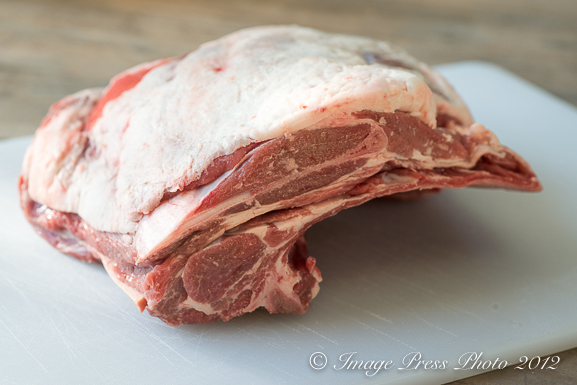
Lamb shoulder from Border Springs Farm
With this French inspired dish, I decided to keep the lamb shoulder from Border Springs Farm intact to preserve the integrity of the meat and to ensure the best flavor would be achieved in the final dish by keeping the bone in. While I thought about breaking it down and doing either a boneless shoulder roast, a roulade or chops, I opted for searing and then braising the entire piece whole. I knew this would not only give me optimum flavor, but would also keep the meat moist and tender.
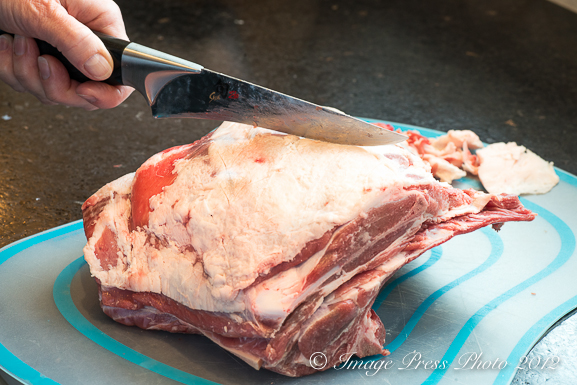
Score the fat cap to allow the flavors to get down into the meat

Place the garlic slices in the slits to infuse the flavors deep into the meat
I scored the fat cap prior to searing the shoulder and inserted thin slices of garlic in the lamb to infuse the flavor deep into the meat and then seared it in Georgia olive oil on both sides. I removed the meat and the fat from the Dutch oven and then added diced 18-month aged Benton’s Country Ham (Madisonville, TN) to the pan to render the fat, just as you would a pancetta.

Yes, we really do make a very nice olive oil in Georgia
The cooked country ham pieces were set aside and I then sautéed shallots, cipollini onions, sliced carrots, and garlic in the rendered fat until caramelized. I used the cipollini onions and shallots in place of a yellow onion to give a sweetness to the sauce. To the cooked vegetables, I added a Burgundy wine (the French version of Pinot noir), homemade chicken stock, tomatoes, the cooked country ham, chopped rosemary, and a few sprigs of lemon thyme. I used the lemon thyme to add a note of citrus to the dish.

Baste the seared lamb to keep it moist before braising in the oven.
The seared lamb was placed on top of the liquids and vegetables in the Dutch oven with the fat side up and I basted the shoulder with the liquids. I braised the lamb in the oven for one hour. Removing the pan after this time, I turned the meat over so the fat side was down, basted the shoulder several times and then added rough chopped fennel to the braising liquids, for an additional complexity and level of flavor.
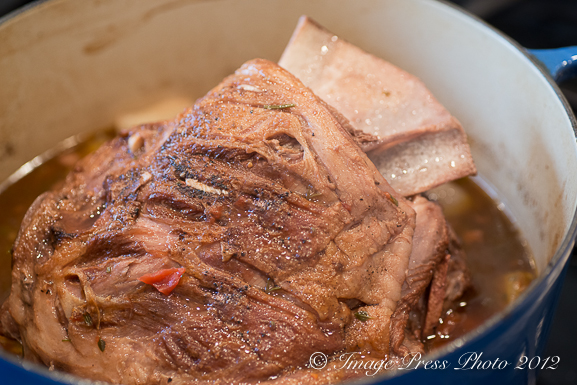
The lamb was perfectly tender and moist and the fragrance from cooking for hours was intoxicating
One more hour in the oven yielded a perfectly cooked lamb shoulder; moist and tender, aromatic and full of beautiful flavors, yet not overwhelming the mild flavor of the lamb itself. At this point, I removed the shoulder and strained the liquids and processed the vegetables in a food processor in order to add some of the vegetable mixture back into the sauce.
I refrigerated the lamb and sauce overnight, as I prefer this method. This allows for an easy removal of the hardened fat from the surface of the liquids and also gives the flavors time to come together. An alternative would be to use a fat separator to skim the fat from the sauce and serve the dish the same day, but the flavors truly are best when allowed to rest overnight.
The next day, after removing the fat from the surface, I slowly reheated the lamb and sauce together in the Dutch oven. I then reduced the sauce and thickened it with a slurry of cornstarch and water to achieve a nice consistency for serving with the meat.
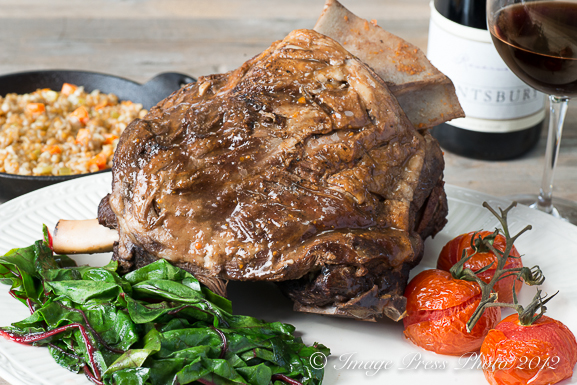
Epaule d’Agneau au Vin (Lamb au Vin)
I chose to pair the lamb with a side dish of Piccolo Farrotto, made with Farro Piccolo from Anson Mills. Glenn Roberts, the inspired genius behind Anson Mills, located in Columbia, SC, plays an integral role in preserving the original and heirloom seeds and grains that came to this country with the slave trade and other immigrants that first settled in the South. Roberts’ efforts and products are greatly supported and used by many chefs throughout the South, particularly in Charleston, so I thought there would be no better complement to the lamb. This ancient grain, dating back 10,000 years and native to northern Africa and parts of the Mediterranean, is only grown by Anson Mills in the United States. (Anson Mill’s products are available for purchase online.)
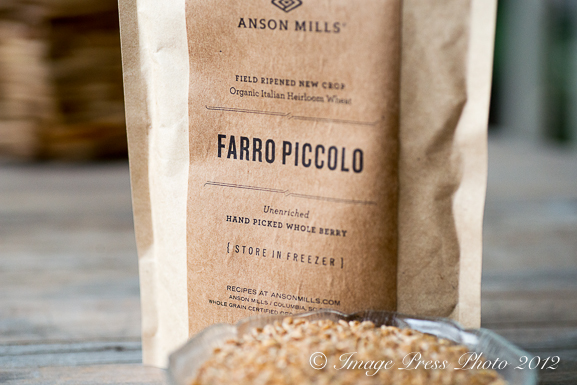
You pulse the farro in a food processor to crack the bran layer before cooking it in this receipe
Piccolo Farrotto is prepared much like a risotto and was creamy and rich, finished with just a bit of Parmesan cheese. The flavors stood up to and paired well with the layers of flavor in the lamb and red wine sauce and the contrast in textures was particularly good, with the bit of crunch from the grain. It was far more intriguing and complex than serving it with roasted root vegetables, which would be the first inclination to serve with the lamb. Both dishes were rustic in style and were well suited to each other, particularly when paired with the accompanying braised greens and oven roasted tomatoes.
We served the dish with a lovely bottle of Pinot noir, the American version of the Burgundy grape. This particular Pinot, Saintsbury Reserve, was the very first bottle of wine Mr. B and I shared on our first date in Boston, Massachusetts. It is also the red wine we served at our wedding ten years ago, so it brings back fond memories and has a special significance for us. In fact, we used to spend date nights browsing wine shops in Boston and Atlanta looking for this wine to rekindle the romance of that first date, so I would have to say it may be one of the reasons I moved back to the South.
Not wanting to waste one bite of any of these dishes, we served the leftover lamb with the red wine sauce over the Piccolo Farrotto the next day. This dish gave a whole new meaning to the term “leftovers.” This easily could have been served as the main dish, it was that good.

The lamb was every bit as good served the next day
If you like my Epaule d’Agneau au Vin (Lamb au Vin), I would appreciate your vote, once again, in the Lambs & Clams Cooking Contest. You need to go to Facebook and first “Like” the Charleston Food and Wine Festival. You will then be able to access the voting link to the Lambs & Clams Cooking Contest from the burgundy colored tab at the top right-hand side of their Facebook page that says “Lambs & Clams Contest.” Voting ends Friday, December 21, 2012. Thank you!
Here are the other participants and their recipes:
Lynda of Taste Food Blog
Peter Barrett of A Cook Blog
Olga Berman of Mango Tomato
David Dadekian of Eat Drink RI
Heather Scholten of Farmgirl Gourmet
Cecilia Stoute of One Vanilla Bean
Vivek Surti of Vivek’s Epicurean Adventures
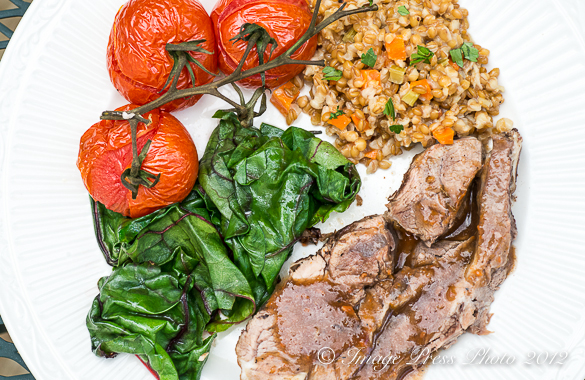
Epaule d’Agneau au Vin (Lamb au Vin)

Epaule d'Agneau au Vin (Lamb au Vin)
Ingredients:
1 4.8 pound whole lamb shoulder roast (bone-in)
Kosher salt
Freshly ground black pepper
3 tablespoons Extra-virgin olive oil (I used Georgia Olives Farm olive oil)
2 large cloves garlic, thinly sliced
1/4 cup 18-month Benton’s Smoky Mountain Country Ham, diced
3 carrots, cut into 1-inch pieces
4 cipollini onions, peeled
4 large shallots, peeled
1 clove garlic, minced
2 cups Pinot noir or Burgundy wine
1 cup homemade chicken stock or low-sodium chicken broth (I used homemade stock)
1 can (15 ounces) diced tomatoes, drained
1 teaspoon chopped, fresh rosemary
Few sprigs fresh lemon thyme
1 large fennel bulb, trimmed and rough chopped
Sea salt & freshly ground pepper, to taste
Optional - A cornstarch and water slurry, for thickening
Directions:
1. Remove the lamb shoulder from the refrigerator and let sit at room temperature, covered, for at least 30 minutes. Preheat oven to 300 degrees (for convection) or 325 degrees (standard oven).
2. Score the fat cap on the lamb. Make deep slits in the fat and meat all over the shoulder. Place slices of garlic into those slits. Sprinkle entire lamb shoulder generously with Kosher salt and freshly ground black pepper.
3. Heat olive oil in a large, ovenproof Dutch oven over medium-high heat. Add the lamb, fat side down and sear until brown, about 10-12 minutes. If the oil becomes too hot and starts smoking, turn the heat down a bit. Make sure you have a nice sear before turning the meat over to brown the meat on the other side, approximately 3-5 minutes more. Remove the lamb from the pan to a platter, cover it, and then remove the fat from the pan and set aside.
4. Keeping the heat at medium-high, add the country ham pieces to the Dutch oven and brown, rendering the fat. Once they are nicely browned, remove the country ham to a small dish and set aside.
5. Leave about 2 to 3 tablespoons of fat from the country ham in the Dutch oven and over medium-high heat, add the cipollini onions and shallots. When they begin to brown slightly, after a few minutes, add the carrots. (If you need more fat, add a tablespoon of the reserved lamb fat.) Adjust heat to medium and cook the vegetables, stirring occasionally until they begin to get a bit soft and are beginning to have a nice caramelization, about 10-15 minutes. Add the minced garlic and cook, stirring, for another minute.
6. Add the Pinto or Burgundy wine to the Dutch oven, deglazing the pan and scraping up the brown bits. Add the chicken stock, drained tomatoes, rosemary, and lemon thyme. Stir well and bring to a boil.
7. Place the lamb, fat side up, in the Dutch oven. Baste a few times with the liquids. Cover tightly and cook for one hour in the preheated oven.
8. Remove the Dutch oven from the oven and carefully turn over the lamb shoulder, so that the fat side is now facing down. Add the chopped fennel to the liquids. Baste the lamb several times and return to the oven for an additional hour.
9. Remove the Dutch oven from the oven and then carefully remove the lamb from the pot, cover and set aside. Strain the liquids through a sieve, reserving the cooked vegetables, discarding the stems from the lemon thyme. Process the vegetables in a food processor until the mixture is well pureed. Depending on your taste, add some of the vegetable mixture back to the sauce. (I added about 3/4 cup of the pureed mixture back into the sauce, to achieve a nice consistency and flavor.) * The sauce will be reduced further. Add the lamb back to the Dutch oven.
10. Refrigerate the lamb and the sauce together overnight (I prefer to do this as it allows for easy removal the fat from the surface the next day. It also gives the dish time for the flavors come together.)
11. Remove the Dutch oven from the refrigerator and scrape the hardened fat from the surface of the sauce. Slowly reheat the lamb and sauce together over a low heat, basting the shoulder periodically. When the lamb is thoroughly warmed through, remove, cover, and keep warm. Bring the sauce to a boil, reduce over medium-high heat, for about 10 minutes. If you like a thinner consistency (more like au jus), you can serve it as it. Taste for seasonings. I wanted a thicker sauce for serving, so I used a slurry to achieve a gravy-like consistency.
11. Remove the arm, blade, and rib bones, slicing the lamb as you would for shoulder chops, but serve it boneless. Accompany the lamb with the red wine sauce and Piccolo Farrotto.

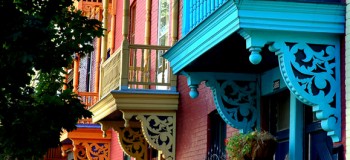














Looks like you’ve got another winner, Gwen. Like I’ve told you before (I think)..I don’t eat lamb, but I have no doubt I wouldn’t be able to resist this! I think subbing lamb for chicken in the classic ‘au vin’ is brilliant, but your brilliance in the kuchen never ceases to amaze me.
Every thing about this is lovely, Gwen. The farro is a great idea to pair with the lamb. The sauce looks like it’s ready for me to dunk some crunchy bread in it. I wish you luck in this round too:)xx
Looks absolutely amazing, Gwen!! I would like a plate or two of that!!